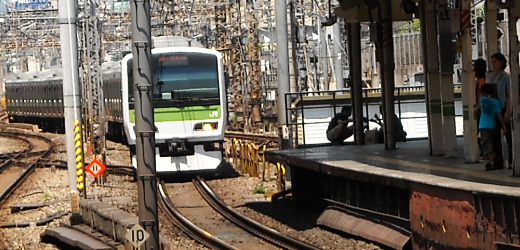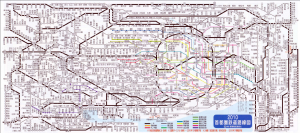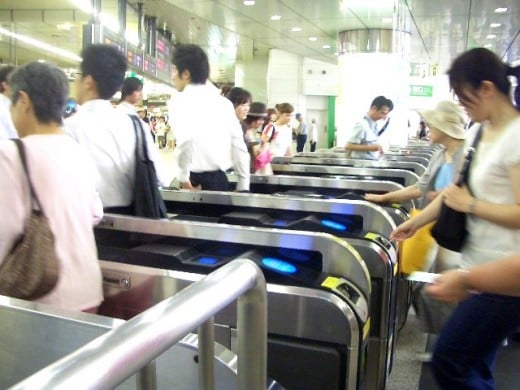- HubPages»
- Travel and Places»
- Visiting Asia»
- Eastern Asia
How to Take the Train / Subway in Japan

Rail travel is perhaps the most efficient, frequented, and fun form of public transportation in all of Japan. If you want to get around at all then it is inevitable that you take the train or subway at some point during your stay in Japan.
However, taking the train can be a daunting task, especially in smaller rail hubs where English is not necessarily inevitable. There are also a lot of etiquette rules that should be followed for the most pleasant experience possible.
So how do you take the train in Japan? It's actually quite easy, if you know where you are and where you're going. This hub will provide an overview of how to consult rail maps, buy tickets, ride trains, etiquette, and useful Japanese to know in case you get confused in real life.This hub, however, does not cover shinkansen travel.

Consulting Rail Maps
Either when you arrive at your local station or in advance, decide where it is you want/need to go and get a plan of attack. Most rail maps can be downloaded online these days, but stations also offer paper maps alongside their giant maps hanging on the walls. Almost all train lines, including the rural ones, are bilingual in Japanese and English.
If you need to know the timing of connections and how much fares will cost ahead of time, Hyperdia is the go-to site for finding this information.
For the most part, figuring out which direction to go is simple and pretty straightforward - it's when you get the major urban centers, such as Tokyo, Osaka, or Nagoya, that your head may start spinning as colorful lines and repetitive station names bombard your brain. Most cities separate their top-rail and subway systems when it comes to mapping, but be aware that many lines intersect at the same stations to make transferring convenient. As a general rule, if two lines in an area use the same station name somewhere, it is the same station. Likewise, particularly in more suburban and rural areas, lines may have stations near each other but not in the same building. In this case, the stations will usually have a slight difference in station names: an example of this is JR's "Unuma Station" in Gifu Prefecture, which is about a three minute walk away from Meitetsu's "Shin Unuma Station".
Figuring out where you're going is half the battle: next comes buying the ticket and actually riding the train!
Buying Day Passes
Buying Tickets
Once you arrive at your starting station, it's time to buy a ticket! Most stations you're likely to come across in your travels will have automated ticket machines just outside the entrance gates. Some will be computerized and others will have old-style push buttons. But regardless, almost all ticket machines, especially those in urban areas, will have an English option. Don't worry, you don't lose any cool points for having to use English to make your day easier.
Regardless if you're using an English or Japanese interface, most ticket machines work the same way. What you want to do is select the fare amount you need for your journey. Some lines will provide station destinations, but the price is the same either way. However, you probably won't be allowed to select the amount until you've put in the correct amount of money. Once enough money has been received all applicable fare amounts will be highlighted for selection. Choose your amount and watch as the machine spits out your ticket and any change.
If you're going to be doing a lot of traveling in one area, it's best to see if there's a day pass offered for the surrounding lines. This will not only save you hundreds of yen in a day, but also save you time from having to buy a ticket in case you're about to miss your train. If day passes are available, they can be found under the English menus on ticket machines. Be sure to check which lines a day pass is applicable for!
NOTE: If transferring lines ran by the same company (ex: JR), you usually do not have to buy separate tickets! Instead, check what the fare is from your stating station to your ultimate destination and buy a ticket for that amount. When you switch trains, do not exit the gates. Companies have all their lines together behind the same gates at any one station. Simply change platforms as opposed to exiting the gates and buying a new ticket for your new train.

Riding Trains
Once you have your ticket, it's time to board your train! Just a few yards away from the ticket machines are the ticket gates. If you look below you will see either a Red X or a Yellow Arrow: Red Xs mean "do not enter" and are for foot traffic coming out of the gates, and Yellow Arrows mean that you should enter through that gate. Just above the Yellow Arrow is a slot to insert the ticket you just bought. Push it in and watch it pop out the other side! Hurry up, though, because not only is there probably traffic behind you, but if you don't grab your ticket and exit the gate fast enough, it might close on you!
When through the gate (don't forget to grab your ticket!) look up at the signs that tell you what train is leaving when and from what track. This is how you will find out what platform to go to, assuming there is more than one platform at your station. This is a good time to make sure you know the kanji of the most important stations, since most signs only show kanji. On most JR lines, however, and generally in more urban areas, signs will flash between kanji and roman letters. Most route maps and time tables will be bilingual as well.
The next trick is to make sure you get on the right kind of train. There are many types of trains in Japan, especially in cities, and getting on the wrong one can mean either missing your stop entirely or getting there a half hour slower. Be sure to thoroughly check time tables and route maps to know which train you want to get on! Here's a breakdown of the most common types of trains in Japan:
普通列車 / 各駅停車 Futsuu-Resha / Kakueki-teisha - Local Train. Stops at every station until final destination.
快速 Kaisoku - Rapid Train. Skips some smaller stations but still hits most of them.
急行 Kyuukou - Express Train. Skips all smaller stations and hits only medium and major stations.
特急 Tokkyuu - Limited Express Train. Hits very few stations, usually only the major stations.
NOTE: Some of the faster trains on any line and in any company may require more expensive tickets, reservations, or even things like being reserved only for business people. Check ahead to see if this applies to your train.
Most, aside from rural stations, will announce when your train arrives. Be sure to line up (just follow the rest of the flow of foot traffic if you don't know where to stand) behind the yellow line on the platform and wait for your train to pull in. Once the disembarkers are out, you're free to enter the train. Unless otherwise stated on your ticket, you're free to sit anywhere you want. Keep an ear out for the announcement of your stop. The major lines in major cities usually have multilingual announcements.
Follow the signs on your disembarkment platform for your desired exit gate (if there are more than one). Just as when you entered, put your ticket above the Yellow Arrow. This time you will not get your ticket back (if it's a one-time use ticket). If the fare is accounted for you'll be let through.
Went further than you anticipated? Never fear, there are fare adjustment machines just before every gate. These only apply for tickets that are underfunded, however. If you need a refund because you went a shorter distance than anticipated, you'll have to speak to a station staff member if available.
NOTE ON RURAL LINES: Many super small stations will not have gates or ticket machines. Uh oh! What now? Every line in this case is different, but experiences says that most assume you will buy a ticket from a staff person after you get on the train or when you get off. Don't worry about this, however, if you're not planning to go up into the, say, Japanese Alps.
Commuting Time
Etiquette
Like while doing anything else in Japan, etiquette is a big deal when riding rail. While you're unlikely to notice any serious side-eyes from other passengers or even be kicked off for not following these guidelines, it's still worth the time and effort to familiarize yourself with what's expected of you when riding rail in Japan.
- Don't be shy about pushing people. Seems rather counterproductive, but it's really not. During the congested commuting times you may find yourself elbow to elbow with fellow foreigners and native Japanese alike. Seen those videos of station staff literally shoving people into trains? That's a reality. So long as you're not actively hurting anybody (and if you do accidentally hit somebody, an apology usually suffices) it's okay to push and shove a little if necessary. Odds are you're gonna get shoved as it is!
- Give up your seat to people who need it if the train is crowded. Most train cars have a special section at the end for the handicapped, elderly, pregnant, and parents with small children. You are expected to give up your seat to any of them if you are sitting in this section.
- Turn off your cell phone, or at least put it on silent if you're going to be on the train for a long time. Mouthing away on your phone is usually considered bad manners, although plenty of people do it. The only time this becomes an actual necessity is if you're sitting or standing in an area described directly above - many elderly (and handicapped) people may have pacemakers or the like that could be disturbed by the signals from your cell phone.
- Don't eat, and don't drink unless you absolutely have to. And if you do, be as quiet and discreet about it as possible. It's considered rude and gross to eat and drink on a train, although at some point everyone has to do it.This usually applies mostly to urban trains where congestion is more likely. Rural trains tend to be a free-for-all of people bringing on boxed lunches and munching away as they watch the countryside go by.
- Don't talk loudly. Many people sleep on trains between home and work/school. Many others are doing (home)work or just trying to relax. Of course you're allowed to talk to your neighbor/friend, but try not to let everyone in the car in on what's going on in your life. This is a point particularly for foreigners who often don't realize just how loud they're talking.
It really isn't that much, but even this much can go a long way to enjoying your ride.
Useful Japanese
Even with all the planning you may still find yourself lost and stressed at a station. Here's some Japanese to use with other passengers and train staff if necessary.
1. "Kono densha wa ___-eki de tomarimasu ka?" / "Does this train stop at ___ Station?" - Probably the most powerful phrase you could use. Ask platform staff or even drivers - if they don't know, nobody knows!
2. "___-eki kara ____-made wa ikura desu ka?" / "How much is it from ___ Station to ___ Station?" - Always good to know.
3. "Shuuden wa nan-ji desu ka?" / "When is the last train?" - Most trains stop running around midnight even in the cities. Plan accordingly.
4. "Doko de norikaeru no desu ka?" / "Where do I transfer trains?" - "norikae" means to change trains. You'll often hear it announced before stations while riding the train. If you need to change lines, keep your ears open.
5. "Tsugi wa ____ desu." / "The next station is ____." - Even train veterans sometimes don't pay attention to the next station. Always pay attention!
Enjoy the Ride
Riding the train or subway in Japan can seem daunting at first, but it helps to think of it this way: it's sink or swim. Either you learn the rules of the rails and become confident and knowledgeable quickly, or you never do. This isn't meant to scare, but to instead reassure that in no time at all you will become familiar with riding rail in Japan, and may even begin to plan whole trips around taking the train.
Enjoy!




